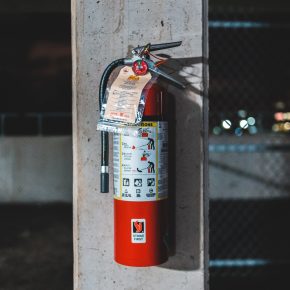
GUEST ARTICLE: Industry reacts to new fire safety regulations
Fire safety is top of the agenda when it comes to commercial construction. Emerging legislation, such as the Fire Safety (England) Regulations 2022, which came into force as of January this year, continue to pressure developers to address concerns around fire safety assessments and checks…
Michael Gove’s recent warning to developers: ‘agree to cladding remediation or find another industry’ was the latest in government interventions to tackle a negligent attitude towards fire safety and compliance in high-risk and high-rise properties.
These new stricter, firmer laws are a sign of the times – fire safety cannot and will not be ignored. Here, industry experts give their thoughts on the new regulations, including Ian King, Chief Operating Officer at Fire retardant technology company Zeroignition, Rob Norton, UK Regional Director at PlanRadar, a digital construction field management platform specialising in fire safety documentation, task management and communication and Steve Callow, Housing Manager at MPA Masonry, an association representing the UK’s concrete and aircrete block manufacturers.

Ian King
“We need to go above and beyond mere ‘compliance’ and stop developers cutting corners and side-lining safety for financial gain. The new regulations are a long-overdue shift in momentum.
“Incoming tighter standards will help embed a more holistic outlook on fire safety that closely assesses the materials used in buildings, how they are assembled into systems, and what protection is in place.
“The renewed focus on processes, monitoring and culpability using digital systems will make it harder for newly appointed responsible persons and developers to avoid thorough fire risk assessments. This will help maintain a clearer ‘golden thread’ of information on inspections and building plans.”
“It’s a step in the right direction, but ultimately just the tip of the iceberg. I just pray there will be more to come in the near future.”
Rob Norton
“2023 is the year that contractors have to get to grips with fire safety. These latest changes are symbolic of a wider sentiment – the government has fire safety compliance in its sights.
“By placing greater emphasis on the Responsible Person (RP), the risk of potential prosecution and heavy fines will no doubt be an effective motivator and should go some way to improving the lackadaisical approach to safety checks – particularly around fire doors.
“Businesses now need to be solutions-driven. Opting for digital platforms that can capture and record evidence of fire assessments and completed work will be instrumental in meeting these new legal requirements. Incorporating a digital-first approach will also help to fill the skills gap left by a lack of fire engineers and eliminate human error throughout fire safety assessments.”
Steve Callow
“The new regulations are a welcome step forward and will push housebuilders and developers to demonstrate best practice, and certify all building products used in residential construction are safe within the specified system.
“It’s clear we need to adopt a more Safety-first approach to the way we build and, hopefully, these tougher regulations do just that. I hope it will finally put an end to careless value engineering and create a far more robust framework for fire inspection. I hope it will also make developers think carefully about the types of materials used.
“Only a month ago, the National Fire Chiefs Council highlighted the significant risks posed by modular and engineered timber for high-rise urban construction. This should make those developers tempted by these methods to think carefully. It’s not to say they don’t have their place in modern construction, but they need to be considered in line with the new regulations and incoming gateways.
“Affordable homes are the goal of both government and the wider housebuilding sector. However, we should never rush into building new homes at the expense of occupant safety. Let’s look to those materials with a proven track record for fire resistance.
“Masonry is perfectly suited to meet these new requirements, as it’s perfect for cavity wall construction, inherently non-combustible and it lowers fire risk by ensuring greater structural integrity. Occupant safety is paramount to all these considerations, and masonry is perfectly placed to deliver upon this.”
Latest news

26th July 2024
Enfield Speciality Doors completes world-class project for Atlas Copco HQ
A rundown office and warehouse building completely transformed into a modern headquarters for Atlas Copco has been fitted with more than 120 internal fire doors from Enfield Speciality Doors.
Posted in Access Control & Door Entry Systems, Articles, Building Industry News, Building Products & Structures, Building Systems, Case Studies, Doors, Interior Design & Construction, Interiors, Posts, Restoration & Refurbishment, Retrofit & Renovation, Security and Fire Protection, Sustainability & Energy Efficiency, Timber Buildings and Timber Products, Wooden products
26th July 2024
Abloy UK launches new white paper
Abloy UK, a leading provider of security and access control solutions, has launched a new white paper.
Posted in Access Control & Door Entry Systems, Architectural Ironmongery, Articles, Building Industry News, Building Products & Structures, Building Services, Doors, Facility Management & Building Services, Health & Safety, Information Technology, Innovations & New Products, Publications, Research & Materials Testing, Security and Fire Protection
26th July 2024
MCRMA Member Profile: David Roy, Director of Roofconsult
David Roy of MCRMA member company Roofconsult has more than 50 years’ experience to draw upon working in the building envelope sector and a unique perspective on how it has changed in that time.
Posted in Articles, BIM, Infrastructure & CAD Software, Building Associations & Institutes, Building Industry News, Building Products & Structures, Building Services, Building Systems, Cladding, Information Technology, Restoration & Refurbishment, Retrofit & Renovation, Roofs, Walls
26th July 2024
Strand: Enhancing Door Functionality and Safety
Craig Fox, Sales Director for Strand Hardware, outlines how door industry professionals might apply door limiting stays…
Posted in Architectural Ironmongery, Articles, Building Industry News, Building Products & Structures, Building Services, Doors, Facility Management & Building Services, Health & Safety, Restoration & Refurbishment, Retrofit & Renovation
 Sign up:
Sign up: